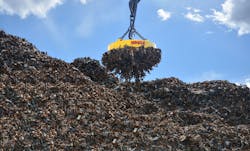Five Tech Tips for Lifting Magnets and Allied Equipment
Some magnets are simple, like the handheld units used to affix photos, calendars, and notes to your refrigerator. But the magnets on material handlers designed to lift metals are much more complicated.
Mark Volansky, director of sales for Winkle Industries, answers five key questions about lifting magnets, power supply sources, and electrical control systems, providing a look at some of the technologies around magnets used in the material handling and scrap industries.
1. Is there equipment available that can help extend magnet service life?
“Yes, there are monitors and meter packages that aid in the safe use and prevention of premature magnet failures,” Volansky says. “Both devices provide operators the ability to verify electrical performance. The primary difference is that the monitor submits alerts when magnet current limits have been exceeded and can disable subsequent lifts. Both pieces of equipment are valuable tools for extending the service life of electro-lifting magnets.”
2. How can you minimize or prevent damage to magnet power leads/cable?
“The most effective way to prevent damage to magnet power leads is through the use of a cable protection system,” Volansky says. “The Bullet Cable Protector prevents abrasions, nicks, cuts, and heavy impacts, which are leading causes to premature magnet and electrical system failures.”
3. What are the differences between DC constant potential and solid-state magnet controllers?
“A DC constant-potential controller utilizes electro-mechanical components to safely charge and discharge magnetic fields. These units historically require constant maintenance and do not provide any protection or diagnostic features,” Volansky says. “Solid-State controllers are virtually maintenance-free ‘intelligent’ devices that protect magnets, power sources, and personnel from potentially dangerous conditions. These units also increase cycle times and throughput with faster charge times and cleaner drop cycles.”
4. What are the advantages of an AC to DC magnet power source?
“An AC to DC power source utilizes a maintenance-free, brushless AC generator,” Volansky says. “The output voltage is converted through the use of a solid-state controller to produce DC magnet power. AC versus DC generators offer a wider operating speed range and output voltage is less dependent on the rpm.” Additionally, AC units are dimensionally smaller than equivalent kW-rated DC generators, Volansky says.
5. Why is a magnet inspection program important?
“A magnet inspection program is a primary tool for proactively aiding in safe use, preventing the high costs of repairs, and ensuring optimum performance,” Volansky says.
“The program should incorporate verifying and documenting electrical readings such as current, resistance, and meg-ohms at consistent intervals. It is equally important to include visually inspecting the mechanical condition of your magnets, such as welds, wear depth, chain wear, and more. Both procedures will capture minor problems before they become major issues.”
Source: Winkle Industries


